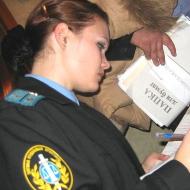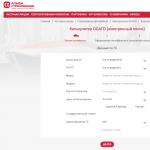
Where will be the CCAD on the map. CCAD scheme: construction will not affect settlements and cottage villages
The completion of the construction of the first starting complex of the Central Ring Road (CCAD) is scheduled for 2019.
According to the city planning policy and construction complex of the city of Moscow, at the moment 40% From the entire volume of work. Starting Complex No. 1 with a length of 49.5 km passes from the M-4 Don of Minsk highway on the territory of the city district Domodedovo, Podolsky district of the Moscow Region, the Trinity Administrative District of Moscow and the City District of Naro-Fominsk. 22 km of the route will be held through the territory of the new Moscow.
Construction financing is carried out at the expense of subsidies. federal budget, Fund of the National Welfare Fund of Russia (FNB) and extrabudgetary sources of financing. The launch complex number 1 will be connected to the launch complex number 5.
First startup Central Ring Road (CCAD)
According to the capital construction complex, the commissioning of the third, fourth and fifth start-up complexes CCAD is scheduled for 2018-2020.
Deadlines are shifted, the cost is growing
In April 2018, the Accounts Chamber revealed violations by almost every TSKAD launcher in part of the work of work, the organization of construction, the adoption of work performed and payment of advances by the customer. In addition, the cost of construction increased by 13,5 billion rubles.
In particular, a network plan-schedule was violated on the start-up complex number 4. Construction and installation work on it should have started back in July 2017, but the workers did not go to the object and in January 2018. The commissioning of this start-up complex was transferred to December 2020. Works on the start-up complex number 3 were not accepted and not paid.
The provisions for the introduction of the first start-up complex - December 2018, but now the Moscow authorities speak of the plans to complete the construction next year.
The fifth launcher will be held through Odintsovo, Istra, Solnechnogorsky districts and the Naro-Fominsky urban district. The overall length of the site is more than 76 km, and a third of them takes place on the Odintsovo district (plots from the 18th to the 36th km and from the 43rd to the 50th). It should be commissioned in December 2018, however, for April 2018, the technical willingness of the facility was only 33% .
Will builders put deadlines Or in the light of the next problems, they will again be shifted?
Fifth launchers TsKAD
Scandalous bill
Previously, it became known that a few years after the construction of the first and fifth sections of CCAD, the builders faced problems - the need to transfer a huge amount of pipelines, power lines and communications. Because of this, construction was suspended.
One of the key was the question of the renewal of land, which is necessary to transfer networks. Sections to transfer communications must be rented or redeeming, but the owners do not always agree to it. Especially when it comes to sites near Moscow.
Currently, the process of transferring communications takes not one year. For the "solution" of this issue, the bill was developed and adopted in January 2018, according to which network owners will receive the right to use the land demanded by them. The innovation will speed up the process of transferring communications tripled. The bill caused an ambiguous reaction, lawyers called it "legalized lawlessness."
According to them, the land owner is given only a month to discuss the terms of the servitude. If negotiations are completed without a result, and the area owner will not have time to go to court during this time, the deadlines for the service and the servitude fee are considered agreed. In addition, if large communications are held through the site (for example, gas pipes), the site should be treated with the payment of full compensation. However, the current bill will avoid these expenses, limiting them with a service fee.
Ecologists beat alarm
The controversial initiative of the legislators is not the first scandal associated with the construction of a ring road. Back in 2016, information appeared on the preparation of the Public Chamber of Appeal to the Government of the Russian Federation with a call to suspend work. According to the Forest Forest Program "Greenpeace Russia" Alexey YaroshenkoThe settlement of the territory around the new route will lead to a drop in the quality of life and the new inflow of "applicants" from the region.
Also, environmental experts stated that the territories are mastered solely in the interests of merchants, and during the construction of the CCAD, about 6 thousand hectares will be cut down, which will become a serious damage "easy capital". The total environmental damage was appreciated in 11 billion rubles.
Experts called for freeze work to re-ecological expertise, revise the project and transfer construction to neighboring regions. But they were not listened to their arguments. Officials do not convince the fact that potential investors are also not ready to build an annular road due to high financial risks.
Ready only one plot
CCAD is a large-scale project for the development of the transport infrastructure of the Moscow region, which was developed at the beginning of zero. Construction began in 2015, at the same time its completion was repeatedly shifted.
CCAD scheme
The main purpose is the unloading of federal roads and the Moscow Ring Road by the redistribution of transit vehicle flow. The total length of the CCAD will be 525 km. For most of the TsKAD route will be held in 400-800 M. From the Moscow Small Ring, bypassing settlements. Most of the road will be paid, residents of the Moscow region benefits for travel.
In November 2017, on the site bypassing Zvenigorod, which is part of the 5th TsKAD launch complex. At the launch ceremony of the Moscow region governor Andrei Vorobyov He declared plans to complete the completion of the work on this section of the CCAD until the end of 2018. Bypassing Zvenigorod became the first open section of the ring highway.
Construction of the CCAD in the Moscow region is in full swing. A new transport ring around the capital is designed to improve transport accessibility Moscow region cities, improve the situation with the infrastructure and development of neighboring and far near Moscow areas.
What is the essence of the CCAD project?
The CCAD or the central annular road is essentially a logical continuation of the diametrical development of the capital highway. In total, it consists of 5 queues (so-called start-up complexes), on 3 of which construction work is being underway.
The main task of the CCAD is, first of all, the unloading of the Moscow Ring Road and the redistribution of the transit flow of vehicles in the suburbs.
The total length of CCAD on the completion of construction will be 525 km. All areas of the central ring road, except for the 5th and 2nd start-up sections of the 5th and 2nd start-up complex, will be a paid motorway wide from 2 to 4 bands in each direction, a fence in the center and the estimated speed of movement to 150 km / h .
According to the authorities, the central annular road in the future is designed to become the key motorway of the new Moscow and the entire neighboring Moscow region.
The history of the emergence of the project and the Economic Justification
For the first time, the need for the construction of the CCAD was noted by the Decree of the Government of the Moscow Region dated December 30, 2003. In 2005, land plots were reserved for these purposes for the construction and reconstruction of existing roads and created open joint-stock company "Central Ring Road Road." 100% of the company's shares belong to the Moscow region.
The construction of the CCAD cost it was not suiced, but here it should be understood that these are not only new highways, but also a new impetus for economic growth in the region. This is a place where residential construction will be actively developing, social and consumer infrastructure facilities will be built, business and industry develop.
Equally important is the value of the CCAD as a connecting and bypass highway around Moscow.
The new route will form the basis of the network of high-speed roads throughout Central Russia and will allow to unload urban trails (those that have a continuation in the Moscow region) and the Moscow Ring Road (Moscow Ring Road).
TsKAD: Construction and detailed map

TsKAD on the map of the Moscow region
As we see, this highway almost completely duplicates the Moscow Ring Road, only much wider.
And it is not surprising. Thus, according to the plans of the governments of Moscow and the Moscow region, in a few years all transit fluxes of cars (primarily freight), which follow the Moscow Ring Road daily will be redirected to the central ring road (CDC). According to experts, we are talking about a figure of about 120-140 thousand cars per day.
Construction of a ring highway is a large-scale project, therefore, it is carried out in several stages. The first section of the CCAD began to build in August 2014, he mainly covered the territory of Novaya Moscow. At the moment, the active construction of two sections of the CCAD - the first and fifth start-up complex are underway.

When is the start planned?
The first section of the TsKAD length of 49.5 km (96 km - 146 km) was already built. He passed through the territories:
- urban district Domodedovo;
- Podolsky district;
- Troitsky administrative district;
- Naro-Fominsky district.
At the idea of \u200b\u200bthe project, 46 bridges and 6 multi-level junites were built on the approved scheme of the section "Number 1". This start-up complex refers to the category of roads "1a", which means that the speed of the road traffic is designed for 140 km per hour. The width of the track: from 4 to 6 lanes in both directions. Given the width and high-speed mode, almost in all areas they are separated by the fences - "bumps".
Movement on this site is scheduled to be launched in the near future. At the end of 2018 - early 2019.
The construction of the first plot will help to greatly unload the departures from Moscow, which are filled with transit transport that make it difficult to access the city. The plot will be paid, for each 1 km you will have to pay 2.32 rubles.
Stages of construction TsKad.
The highway is divided into five launchers:
- In the area of \u200b\u200bthe Small Moscow Ring from the M-4 "Don" route to the M-1 Belarus's highway in the Large Moscow Ring area;
- In the area of \u200b\u200bthe Grand Moskovsky Ring from the M-1 "Belarus" route to the Moscow-St. Petersburg high-speed road;
- In the area of \u200b\u200bthe Small Moscow Ring from the Moscow-Saint-Petersburg high-speed road to the M-7 Volga highway;
- In the area of \u200b\u200bthe Small Moscow Ring from the M-7 "Volga" route to the M-4 DON highway;
- In the area of \u200b\u200bthe Small Moscow Ring from the M-3 "Ukraine" route to the Moscow-St. Petersburg high-speed road.
The exact passage of sites is better to consider on a detailed CCAD scheme:

The length of the first section of the CCAD - 113.45 kilometers, the second plot - 117.86 km, the third - 104.65 km, the fourth - 95.7 km, the fifth - 89.97 km.
It is assumed that about 200 thousand jobs will be created in this zone. The implementation of the entire project is planned to be completed by 2025.

Further development: west of the Moscow region
After starting the first site, the fifth start-up complex will be built and launched. It will pass through the territories:
- Naro-Fominsky;
- Odintsovo;
- Istra;
- Solnechnogorsky districts;
- urban district Zvenigorod.
At the moment, construction is currently being actively underway. The launch of the motorway is scheduled for 2019.

In the future, all these sites should be a single network: CCAD, Moscow Ring Road and the reconstructed Kaluga highway will be a single transport scheme of "New Moscow". In addition, four ceremonial development centers can be created in the area of \u200b\u200bthe central ring road through the territory of Novaya Moscow.
What will happen to the ground next to the CCAD?
According to the authorities, the land along the central ring road will not be confused: permits for the construction of real estate along this route on the territory of the capital will not be issued before approving the unified project planning of the entire territory.
Although, of course, plans for the development of adjacent territories near TsKAD already have: on land plotsadjacent to the central ring, erect housing, manufacturing enterprises, office and commercial real estate.

Also, the authorities of Moscow are planning to build three major transport junctions on the borders of the new Moscow: Trinity and Novomoskovsky districts (TINAO). It will be an interchange at the intersection of CCAD with Warsaw and Kaluga highway, and one more - in the area of \u200b\u200bthe 26th picket. The total length of the new road on the territory of Novaya Moscow will be 22.4 km.
It is interesting to note that the plans of the metropolitan authorities are not included in the construction of a larger number of junctions and congresses on a new highway.
"We do not want CCAD from the high-speed transit route to turn into an urban street," the Government of the Moscow Region emphasized.

A little digit
The central ring road (CCD) is perhaps the most large-scale project for the development of the infrastructure of the Moscow region. The route will cover huge territories, dozens of areas of the Moscow region. Ring 521 kilometer will be closed for remoteness of approximately 50 km from the Moscow Ring Road.
In total, it is planned to build 34 junction, 278 bridges, overpasses and an overpass. The number of strips is 4-8, the estimated speed of movement is 80-140 km per hour.
The construction of the CCAD road is one of the key elements of the Federal Target Program "Development of the Transport System in Russia".
The main social and economic tasks of the CCAD project around Moscow:
- unloading the road network of the metropolis and the near Moscow region from the movement of heavy truck and transit transport;
- rationalization of the structure of the load distribution;
- creating a road component of international transport corridors passing through the territory of the Moscow region;
- formation of conditions complex Development infrastructure and territory of Moscow, Tver, Yaroslavl, Vladimir, Ryazan, Kaluga, Tula, Smolensk regions and Moscow based on the multiplicative effect of the construction of the CCAD;
- reducing the cost of transportation and transport costs for shippers.
The value of the TsKad construction project around Moscow, as a key element of the logistics system of the Moscow region, determines the construction of the largest multifunctional transport and logistics centers. It is planned that they will be located in the nodes of the transport network at the intersection of the main routes of the message.
It is also expected that settlements and towns near TskaD will become more popular, including among those Muscovites who want to move to live for the city constantly, but fears for the inability to quickly get to Moscow and a fairly weak infrastructure beyond. What will undoubtedly increase the demand for home and plots, and therefore the prices of them.

Of course, the new highway will be equipped with all the necessary road service objects. According to the CCAD construction scheme and plans, the infrastructure will include:
- 32 gas stations with minimarkets and fast food cafes;
- 18 stations maintenance for passenger and cargo vehicles;
- 18 motels, 22 cafes-restaurant consisting of 30 multifunctional gas stations.
conclusions
Obviously, such a large-scale project for the construction and reconstruction of highways in the Moscow region has many advantages. Of the minuses, perhaps, it is worth noting that the fare is planned to be paid for most sites (with the exception of the 5th start-up complex and part of the 2nd start-up complex). It is likely that there will be higher prices and infrastructure facilities, as the route is built not only on government money and will be operated on the principles of public-private partnership.
Did you like the article?
Join our community VC, where we tell about all the nuances of country life and real estate.
More recently central ring road (CCAD) was considered a project for a distant perspective, but today the highway is already beginning to acquire real outlines. Last year, the first section of the CCAD was opened for movement. The remaining start-up complexes are actively built - asphalt is laid in many places, the outlines of new junctions are visible. About how work on TsKAD is going on - in the partner project "Kommersant" and the state-owned "Autodor".
A new ring line (index A-113) will be held through the territory of the Moscow region. The future track is divided into 4 sections: 1st (South), 3rd (North), 4th (Eastern) and 5th (Western). 2nd exists in the form of a promising project. The 5th, 3rd and 1st sections are now more active.
TsKAD-West: 5th Section between Kiev and Leningrad highway
Compared to the rest of the future ring highways, the 5th section of the CCAD is, for the most part, a reconstructed "small concrete": A107 will be expanded to 4 lanes, many traffic lights will be removed from it, new junction will be removed.
Scheme of passage of the 5th section of the CCD
An option for the construction of a new route from scratch in this place was considered, but at the stage of the project it became clear that this would have to demolish too many residential buildings. Weighing everything and cons (including the financial costs of paying compensation for the redemption of the Earth), decided not to create unnecessary inconvenience to citizens and expand A107, making traversions of settlements in many places. The total length of the sections of new roads as part of the 5th section is 28.3 km, reconstructed - 41.5 km. This section will be the only free plot throughout the TSKAD - legislation prohibits the fee for travel in the absence of a free alternative detachment.
The only plot on the CCAD, which is already put into operation, is located precisely as part of the 5th section. We are talking about the 3.6-kilometer bypass of the starligor, the movement in which in early November 2017. The transport effect is already visible to the unarmed look: through the historical center of Zvenigorod, there was significantly less cars. Previously, due to the fact that the A-107 passes directly through the city, a large number of trucks accumulated at the crossroads, which was extremely negatively reflected in the ecology and condition of the ancient monasteries, estates and museum complexes.

Future disconnection of TsKAD with M1 "Belarus"
To get an idea of \u200b\u200bwhat is happening on the section, you need to make a kind of "virtual" excursion, moving from the south to the north of the "concrete". On the site between the Zedachi village (here the 5th section begins) and the Kiev highway along the A107 built two new lengths of the length of about 7 km - there are already cars for them. The "concrete" itself is closed here for reconstruction - this is a standard motion spa diagram during repairs.
On the segment between the Kiev highway and M1 "Belarus", the drivers have already seen a new bridge over the gums and a new 1.6-kilometer bypass Yushkovo. Next, the complex area of \u200b\u200breconstruction begins in the zone of dense development - for these works, contractual organizations have already been identified, the construction time will begin. Already after the intersection with M1, a new road will be built along the Petrovsky highway, which should join a new overpass (the project of FCU "CENTERTHERTOMATING", structural unit Rosavtodor), according to which drivers will fall to the Mozhaisk highway. There will be a new road (the earth canvas has already been laid, the laying of asphalt began in April), which will go around the settlements to the overpass over the Zvenigorod railway station - its construction began last autumn.

Future chief tscad with m10 "Russia"
For this erars, drivers will fall around Zvenigorod, already built and commissioned. Then the movement will again go along the expandable "concrete". Immediately at the Ilyinsky highway, in a stretch of about 2.5 km, the movement of transport is already confused into two new stripes, and two old closed for repairs. A similar situation on the plot from M9 to M10: here cars are already traveling along the new roadway. At the intersection of the M10, the 5th section ends.
The main work is now underway on the construction of artificial structures - bridges, overpasses and an overpass, their readiness is estimated by contractors at about 80%. "Willingness" in this case means that buildings are ready for laying asphalt - the coating itself will be applied immediately before the launch of the car movement.
Specifications of the 5th section of the CCAD:
|
TsKAD-North: 3rd Section between Leningrad Highway and M7 "Volga"
As part of the 3rd section, the CCAD is built a completely new route that will work in a paid mode. The 105-kilometer start-up complex will become the longest part of the ring line. The road will allow you to move from the North-West of the Moscow region to the south-east of the Moscow region literally per hour.

Passage Scheme 3rd section TsKAD
The main local attraction is a huge 1.5-kilometer bridge on 23 supports, which turns out the Dmitrov highway, the Moscow channel and the railway branch of the Savelov destination. This is one of the largest artificial structures throughout the CCAD. Already today, drivers moving through Dmitrovka may notice huge concrete bases in the Ikshi area - from here the overpass will begin "movement" over the highway. For the unhindered passage of vessels on water, the arch will be installed - it is already collected at the factory and in the coming months will be transported to the place of installation in a disassembled state. To adjust the heights between the right and left shores of the Channel Channel, a depth of several tens of meters and a volume of 2.2 million cubic meters. meters, because of which the terrain of the west of the future bridge looks rather unusual. The extracted soil, by the way, was used to build embankments on other sites.

Future bridge over the A-104, Savelovsky direction of the railway and the Canal of Moscow
The construction of the 3rd section began in December 2016, and if evaluating the total scope of work, then at the moment it is made by about 30%. In many places, the lading of the earth canvas is completed, the asphalt is laid in places: the total length of the plots with the lower layer of the foundation is about 11 km, this year will become more. To this end, 4 asphalt plants have already been mounted in close proximity to the track, they will soon be removed at full capacity.





The course of construction of the 3rd section of the CCD
The course of construction of the 3rd section of the CCD
The course of construction of the 3rd section of the CCD
The course of construction of the 3rd section of the CCD
As part of the 3rd section - 69 artificial structures (overpass, overpasses). Already clearly visible the outlines of bridges across the rivers of the Blacknava, Chernogolovka, Troy, Zagreb. Began to build one of the overpasses through the "small concrete", although in September last year there was nothing here. There is a construction of a junction near Krasnoarmeysk: for this, a new temporary highway has been erected, which residents can use. The entire local road network, on which the road technique goes today, after the end of the work, be repaired.

Future denouement TsKAD with M7 "Volga" (the project is now being finalized)
Builders promise to finish the 3rd section of the CCAD by the end of 2019. Movement on it can be launched independently of the rest of the sections. Curious item: The section is built in such a way that in the future, when it is necessary, it could be painlessly expanding for another 2 bands - for this now on bridge structures are wide supports and enhanced foundation. The extension is expected already within the second stage of the CCAD project, which can be implemented in 15-20 years. Read more about the second queue below.
Specifications of the 3rd section of the CCAD:
|
TsKAD Southeast: 1st and 4th Sections, between M7 "Volga" and m3 "Ukraine"
1st section (from M4 "Don" to m3 "Ukraine") Build Crocus Group. The company received this site in 2015 after the state-owned company "Autodor" had to change the problem performer.

The scheme of passage of the 1st section of the TsKAD
The section was quite difficult for construction: a new road takes place on a very dense-covered territory. The problem arises with the transfer of all sorts of communications (about 400 objects) - petroleum products, water pipes, a set of power transmission lines. The major main gas pipeline passes, for example, along the Kaluga highway - is now being prepared for its transfer.
In 2010-2011, when the project was preparing, no one knew that from the south Moscow would take a huge territory, for which a future annular road will be held. All this, of course, did not complicate all the processes of coordination, but the specialists of Avtodor and Crocus Group jointly solve these problems.
Specifications of the 1st section of the CCAD:
Another difficult task is to build one of the most complex junctions at the intersection of M4 "Don", A107 and the future TSKAD. Now the first piles are already scored here, it can be seen from the ground and from the air. Here are the first and fourth launchers of the CCAD.
Despite all the difficulties, about 34-40% of the total planned scope of work has already been completed. If you fly over the future road over the route, you can see how kilometers of the earth canvase are laid in many places. In some areas there is already a crushed stone mixture (this is, in fact, the foundation for the future road), in some places and asphalt. It is clearly visible from the ground, because in some places the old "concrete" passes literally from 10-20 meters from the future TsKAD. If there are no additional difficulties, in 2018, the 1st section of the CCAD should be completed and put into operation. There is a chance that some sites can be discovered for the movement of cars even earlier.
On the 4th section (from the M7 "Volga" to M4 "Don") Movement launched work on the preparation of the territory - communications are transferred, the seekers are cut down, the soil is exported. The exit of construction equipment on the band is planned soon.

Scheme of the 4th section of the CCA
Recall that in June 2017, the state company "AVTODOR" signed a concession agreement on the construction and maintenance of the 4th section with the "Southeast Highway" Consortium, after which a certain time has taken the search for strategic investors. In February 2018, during the Russian Investment Forum, financial parameters were recorded in Sochi. Investors who received shares in the consortium, became the "Autoban" group of companies, Russian Foundation Direct investment and Turkish company Makyol. The latter has serious experience in building roads not only in Turkey, but also in Morocco, Azerbaijan and Iraq.
Specifications of the 4th sections of the CCAD:

On CCAD - without barriers
The main inconvenience for users of paid roads has always been barriers in charge charges (PVP), due to which traffic jams are formed, which is especially unpleasant to the "hot" country season. In some places, it is possible to increase the number of movement bands (in the area or to the city, depending on the need), but such an option is not available everywhere.
A more progressive technology is the FreeFlow system, which allows PVP to drive without stopping: The camera reads the number of the moving car, after which the personal account of the owner is determined, from where the money is written off for the passage. Do not even do anything to the driver, everything happens automatically.
FreeFlow is planned to be used on the CCAD. The test operation of the system will begin, perhaps this year will be completed by the summer of 2019, recently stated the first deputy minister of transport of the Russian Federation Yevgeny Dietrich. "The system must work out for some time in the mode of pilot operation so that people looked at it are accustomed and understood what it is," he told. - According to preliminary estimates, the period of test operation should end to May-June next year. " The FreeFlow project will be engaged in a single operator, which will create the Gosset Autodor.
In order for the passage without barriers to earn, changes are needed in the Code of Administrative Offenses of the Russian Federation: you need to enter fines for drivers who are decided to drive along a raid area without making payment. The relevant amendments to the legislation already by the Ministry of Transport and will soon be planned to be submitted to the State Duma. The estimated fine size is 5 thousand rubles. Experts are now discussing where he must go - to the budget of the state or the concessionaire.

It will look like a collection of plans for the CCAD, which provides for the application of Freeflow technology
CKAD-2: Myth or Reality?
From the point of view of the average person seems to be strange to plan the expansion of the road, which is not yet built. But in fact there is a certain logic. For example, when a Novorizhskoe highway was designed in the distant 70s, then the flow streams were small, four lanes were quite enough.
But the Soviet engineers decided to leave the descendants to the descendant in the form of a dividing strip, which could be used to expand the carriageway. What, as a result, the next generation of road users and took advantage.

In general, this is a standard Western practice - to start in 20-30 years to prepare corridors for future tracks. With TsKAD similar situation. It is already clear that after a few decades the need for expansion and this highway may arise, especially since it is planned to be used as part of several international transport corridors.
The technical documentation for sections is mentioned "second queue", which will be designed after increasing the transport loading of the first stage of the CCD. Within the framework of the 3rd section, an expansion from 4 to 6 bands, the construction of the oriental exit to the Dmitrovskoye highway, the northern exit to Noginsk, the junction with the Pushkino-Krasnoarmeysk road and the Shchelkovskaya highway is already scheduled. At one of the sections of the 4th section, it may occur to an extension of the number of bands from 6 to 8 and an interchange will be built with the "MMK-Chechevilovo-MBK" highway.
As part of the second stage, most likely, the mysterious 2nd section will appear - the M-shaped "process" from the main ring, which will begin somewhere between M3 and M2. The history of this site, in fact, is not so mysterious: during development, designers were not allowed to walk near the lands of the Taman Division (owned by the Ministry of Defense), so the CCD was redirected to the other side - bypassing Naro-Fominsk. Later it was decided to make the main ring on another route - according to the "concrete", and the 2nd section should be left for the future. It is possible that someday, after 10-30 years, it will be the beginning of a new infrastructure project - Doubles of the "Big concrete" plot called TsKAD-2.
The decision to build the CCAD was adopted by the Government of the Moscow Region in December 2003 in order to reduce the workload of the Moscow Ring Road, "concrete" (A-107) and "Big concrete" (A-108).
The authorities of the city are planning that after the completion of the construction of approximately 34,000 cars will take place daily through the paid autotrass. The choice of drivers will not be random, because for a small fee they will get such advantages as:
- no traffic jams;
- high-quality modern coating;
- the ability to develop speed up to 150 km / h;
For this purpose, 5 launchers with a total length of 525 km will be erected. The first two plots are almost built:
- Complex number 1. with a length of 113.45 km;
- Complex number 5. More than 89.97 km long.
Coming start
July 26, 2018 Sergei Sobyanin promised that the first two sites of the paid route will be open at the end current yearBut the opening of the third and fourth sites will have to wait, because Vladimir Putin postponed their delivery for 2019.
Startup number 1
The road will cover the territory of the Podolsky and Naro-Fominsky districts, as well as the urban district of Domodedovo and the Trinity Administrative District of the capital. The total length of the commissioned plot will be 49.5 kilometers (from 96 to 146 km).
The 1st section of the TsKAD will differ from other roads.
- 24 guides;
- 12 bridges;
- 6 multi-level junites;
- 3 overpass;
- cloths for 4 - 6 bands in both sides of the movement;
- the presence of a special barrier between flows.
Important! Each kilometer of the site will cost the owners of motor vehicles in 2.32 rubles. There will be no benefits for Muscovites and other categories of motorists.
At the same time, the maximum speed of cars will be 140 km / h.

Startup number 5.
The 5th start-up complex will be laid along Istra, Naro-Fominsky, Odintsovo, Solnechnogorsk districts and the urban district of Zvenigorod. In the future, the Moscow Ring Road, CCAD and the restored Kaluga highway form the "New Moscow" transport system.
In 2017, the segment of the fifth complex (with a length of 3.6 km) became the first operating complex (with a length of 3.6 km), which put the road bypassing Zvenigorod. Complete completion of construction is expected in December 2018. Although in an interview with the media, Andrei Vorobyov, said that at the end of this year will launch 50-90 km. A new ring, he never clarified what kind of plots are we talking about.

Causes of creation
In addition to key technical factors for the construction of the highway, among which experts particularly identify its small load and lack of a large number of congresses and intersections, this project has a whole range of social and planning and urban reasons.
So, if the authorities decided to go along the way to the reconstruction of "concrete", they would have had to face discontent of people whose homes are near the highways. For example, A-107 runs next to those large cities, as:
- Noginsk;
- Bronnitsy;
- Elektrostal;
- Zvenigorod;
- Domodedovo.
At the same time, buildings are located at a distance of just 5-30 m from the "fifty-cell meters". The buildings would be inevitably demolished in case the designers began to expand existing trails.
Note that the central ring will be a 1st technical category road (I-A). This means that the curvature, the width width, the degree of longitudinal slopes and other highways will respond strictly established standards. Therefore, even heavy trucks can safely move at high speeds.
Free A-107 and A-108 cannot boast of compliance with the adopted standards. In order to fit them under the regulation, both highways would have to completely redo, incl. Destroy many adjoining, intersection, displacements and junction. Such reprovers of the transport canvase would be much less appropriate than the construction of a new road near Moscow.

Concept of future development
The authorities are developing plans for the construction of 3 additional transport arteries in Novomoskovsky and Trinity Districts. The junctions will appear at the intersection of CCAD with Kaluga and Warsaw highway and near 26 picket, and their length will be more than 22 km. This department of transport decided to limit it in order not to overfill the transit path.
Recall that the embodiment of the CCAD scheme for the first time began in December 2015. The project, which took over 300 billion rubles to the implementation, was intended to create a modern 530-kilometer highway.
His financing was held using 3 sources:
- investments of investors and concessionaires;
- funds of the National Welfare Fund of Russia;
- subsidies from the federal treasury.

On the paid road fabric (Eastern, North and South Poblers MMK, or A-107), motorists will be able to develop a speed of 140 km / h, and on the only free plot (Western) - 80 km / h. To the final stage, which will fall at 2020-2025, the CCD will be the largest multifunctional transport and logistics center of Moscow and the Moscow region.
Video About the construction of the CCADA in 2018:
CKAD - Central Ring Road Road
03.11.2017
CKAD - Central Ring Road Road Moscow and the Moscow region are designed in accordance with the Federal target program "Modernization of the Transport System of Russia (2002-2010)" approved by the Government Decree Russian Federation from 05.12.2001. According to the official website, the CCAD solves the problem of tasks (transport, social and economic). In connection with the expansion of the borders of Moscow in 2012, part of the CCAD will be held through the territory of Moscow. Description on page according to 1 - Official site of AVTODOR GK, 2 and 3 - Wikipedia.
Scheme and launchers TsKAD on the map
According to the Scheme of the GK Autodor
According to Wikipedia(Business Magazine, No. 5/2015 (Issue, Moscow))
Basic technical parameters TSKAD
Road category: I
Number of traffic strips after completion of the first construction stage: 4
The number of travelers after the completion of the second construction phase: 6/8
Estimated speed: 120 km / h
The total length of the CCAD: 525 km.
The planned date of discovery according to: 2025, according to: The planned deadlines for the construction of the facility (taking into account the training of the territory) - 2014-2018.
Terms of use According to: According to the head of the State Committee for the State Committee, Sergei Kelbach, the passage of the new highway will be paid. The size of the weighted average tariff when traveling on CCAD will be 2.32 r. / Km. The refreshment fee on TsKAD will vary depending on the time of day and the type of transport. A complimentary alternative will be the Moscow Small Ring.
The road will be equipped with a modern automatic road traffic control system, meteorological observation stations, helicopter venues, emergency facilities, drivers for drivers and road service areas.
TsKAD: Construction of the third starting section from M-11 to M-7 Volga. Source: YouTube.com.
The main tasks of TsKAD. :
Unload radial outputs from Moscow and the city's street network from the movement of heavy and transit transport.
Rationalize the structure of the load distribution, "intercept" in long-range entrances to Moscow vehicles, with the subsequent lifting of goods and sending them to other regions with small parties.
Create a road component of international transport corridors (MTC) - №2 (London - Berlin - Warsaw - Minsk - Moscow - Nizhny Novgorod), №9 (Helsinki - Saint Petersburg - Moscow - Kiev - Southeast Europe), MTK "North-South" and MTC "Helsinki - Moscow - Nizhny Novgorod" passing through the territory of the Moscow region.
To form conditions for the integrated development of infrastructure and territories of Moscow and the Moscow region, as well as related regions - Tverskaya, Yaroslavl, Vladimir, Ryazan, Kaluga, Tula and Smolensk based on the multiplicative effect of the construction of the CCD.
Intensify social, economic, interregional and international relations, increase the level of mobility of the population and market entities.
Increase road safety and quality service of the automotive road.
Reduce the cost of transportation and the level of transport costs for shippers.
Reduce the level of negative impact on environment Due to the unloading of head sections of radial roads in the Moscow region.
Optimize (reduce) budget expenditures at the construction stage by attracting extra-budgetary investments in the framework of the concession agreements.
Optimize (reduce) budget expenditures at the stage of operation by attracting concessionaires to the expenditure of funds for the maintenance of the road.
Provide transport infrastructure implementation of comprehensive development programs for the territories of the Moscow Region, carried out without funding from the budget of the Russian Federation.
CCAD construction arguments :
At the stage of substantiation of investments on the basis of economic research data, the forecast of the intensity of motor transport movement was drawn up and two scenarios for the development of the CCAD were considered. According to the first scenario, the track was laid with the maximum use of the bandwidth and structural elements of the Moscow Small Ring (MMK) and the Moscow Big Ring (MBC), according to the second direction. As a result of a comprehensive analysis, it was found that car roads A-107 and A-108 have parameters of the III-IV categories, a significant number of sections with small radius curves in terms of and longitudinal slopes exceeding 40%, numerous intersections and adjoining in one level, displacement Plots of roads in the plan. For more than 40 km, the A-107 road passes through the cities of Noginsk, Elektrostal, Bronnitsy, Zvenigorod and other settlements. In these places, the distance to the development is 5-30 m. The reconstruction of these roads according to the parameters of the I category is associated with the almost complete restructuring and according to the conclusions made in justifying the investment inexperts.
The ability to increase road density in the Moscow region. Now one of the reasons for the high intensity of movement on the roads of the Moscow region is the low density of roads. With the level of motorization of the population of the Moscow region comparable with the level of motorization of the population of Europe, the density of road network in the area of \u200b\u200b4 or more times lower than in Europe, the size of which is close to the territory of the Moscow region. For ten years, the number of passenger cars has sharply increased, both in Moscow (1.6 times) and in the Moscow region (2.9 times). number trucks In Moscow and the Moscow region increased by 2.6 times. The construction of the CCAD will increase the density of roads with solid coating. The new route will be the basis of the high-speed main roads of the Moscow region. The total length of the automotive road will be 521.63 km.
Builder and CCD operator
State company "Russian highways" ("GK Avtodor") - Russian State Company. The state company has been established and operates in order to fulfill the functions of the Customer in the design, construction, reconstruction, overhaul, repair and maintenance of public company roads, the development of lanes of the outlet and roadside bands of the public company, as well as the fulfillment of the authority of the conclusion in conclusion and execution in relation to roads of the state company of concession agreements. Legal basis Activities are regulated federal law dated July 17, 2009 No. 145-FZ "On the state company" Russian road roads "and on the introduction of changes to individual legislative acts Russian Federation".
Information about the areas of construction, reconstruction, integrated arrangement, overhaul and road management schemes in the production zone for the period of operations on the road A-107 "MMK" during the construction of an object on the title: "Central Ring Road Car Road of the Moscow Region, launching complex No. 5" is presented on the official website of the Avtodor Group of Companies on this
















